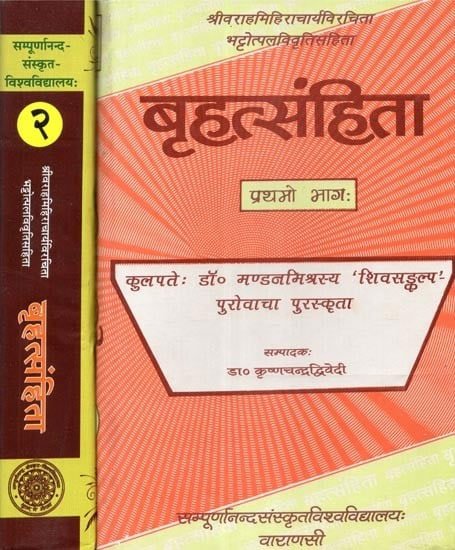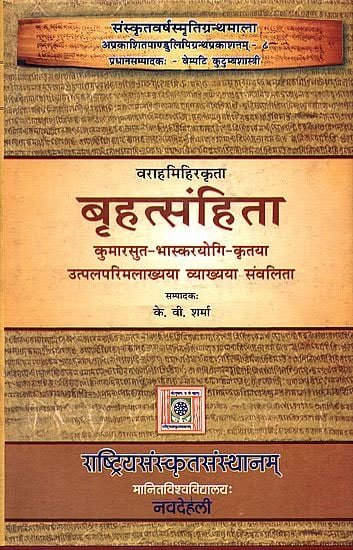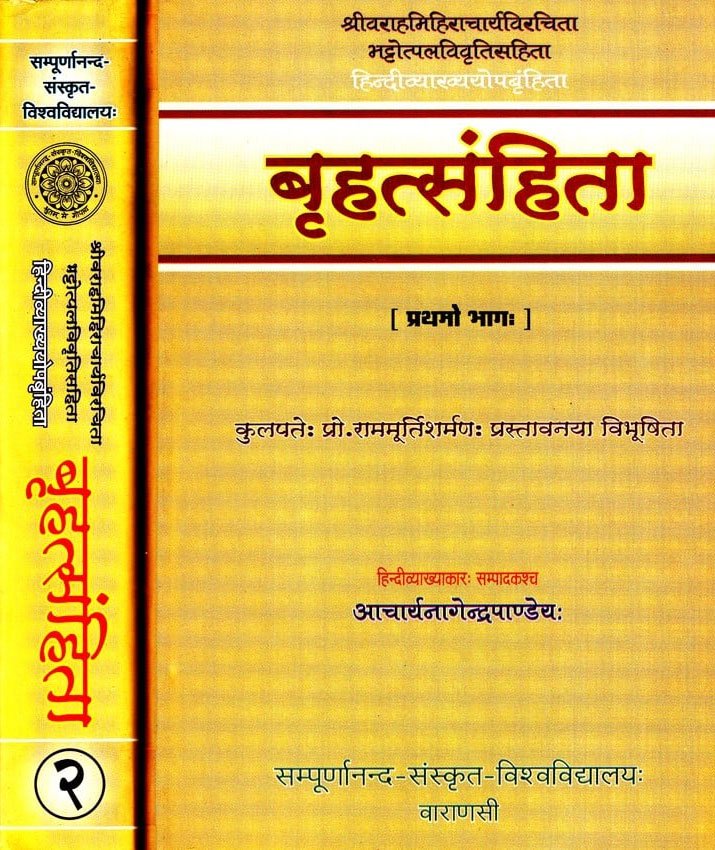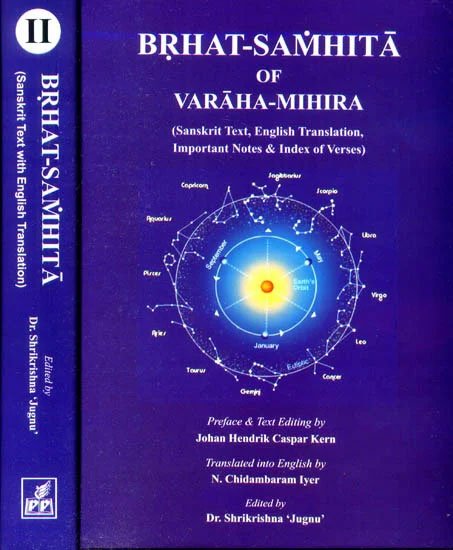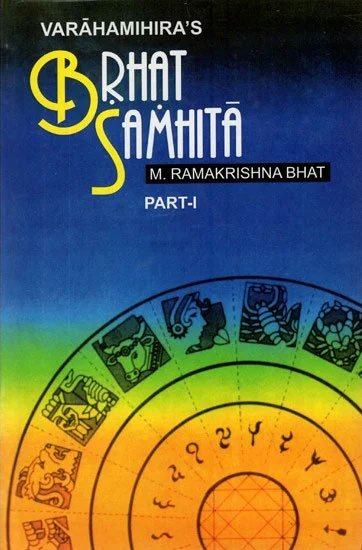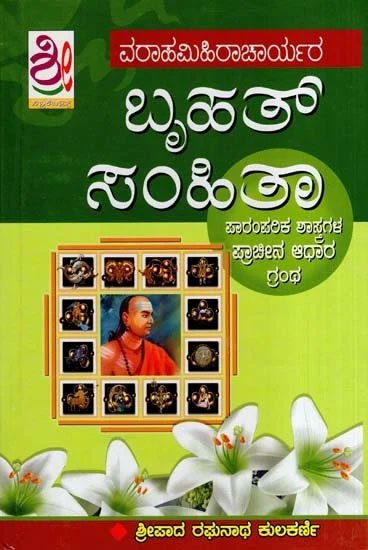Brihat-samhita [sanskrit]
26,560 words
The Sanskrit text of the Brihat-samhita from the 6th-century authored by Varaha Mihira in present-day Ujjain, India. It primarily deals with astrology and astronomy but is presented as an encyclopedia of knowledge.
Verse 80.19
कृष्णश्वेतकपीतकताम्राणामीषदपि च विषमाणाम् ।
त्र्यंशोनम् विषमकपीतयोश्च षड्भागदलहीनम् ॥ १९ ॥
kṛṣṇaśvetakapītakatāmrāṇāmīṣadapi ca viṣamāṇām |
tryaṃśonam viṣamakapītayośca ṣaḍbhāgadalahīnam || 19 ||
The Sanskrit text of Verse 80.19 is contained in the book Brihata Samhita (Sanskrit Text with Hindi Translation) by Pandit Achyutananda Jha. This book is available online or you could buy the latest edition:
Read online Buy now! The Sanskrit text by Pandit Achyutananda Jha (2001)
Glossary of Sanskrit terms
Note: This extracts Sanskrit terms and links to English definitions from the glossary, based on an experimental segmentation of verse (80.19). Some terms could be superfluous while some might not be mentioned. Click on the word to show English definitions.
Krishna, Shvetaka, Pitaka, Tamra, Ishat, Api, Vishama, Tryamsha, Una, Vishamaka, Pita, Shadbhagadala, Hina,
Analysis of Sanskrit grammar
Note: this is an experimental feature and only shows the first possible analysis of the Sanskrit text (Verse 80.19). If the system was successful in segmenting the sentence, you will see of which words it is made up of, generally consisting of Nouns, Pronouns, Verbs, Participles and Indeclinables. Click on the link to show all possible derivations of the word.
- Line 1: “kṛṣṇaśvetakapītakatāmrāṇāmīṣadapi ca viṣamāṇām ”
- kṛṣṇa -
-
kṛṣṇa (noun, masculine)[compound], [vocative single]kṛṣṇa (noun, neuter)[compound], [vocative single]
- śvetaka -
-
śvetaka (noun, masculine)[compound], [vocative single]śvetaka (noun, neuter)[compound], [vocative single]
- pītaka -
-
pītaka (noun, masculine)[compound], [vocative single]pītaka (noun, neuter)[compound], [vocative single]
- tāmrāṇām -
-
tāmra (noun, masculine)[genitive plural]tāmra (noun, neuter)[genitive plural]tāmrā (noun, feminine)[genitive plural]
- īṣad -
-
īṣat (indeclinable adverb)[indeclinable adverb]īṣat (noun, masculine)[compound]īṣat (noun, neuter)[nominative single], [vocative single], [accusative single]
- api -
-
api (indeclinable preposition)[indeclinable preposition]ap (noun, neuter)[locative single]
- ca -
-
ca (indeclinable conjunction)[indeclinable conjunction]ca (noun, masculine)[compound], [vocative single]ca (noun, neuter)[compound], [vocative single]
- viṣamāṇām -
-
viṣama (noun, masculine)[genitive plural]viṣama (noun, neuter)[genitive plural]viṣamā (noun, feminine)[genitive plural]
- Line 2: “tryaṃśonam viṣamakapītayośca ṣaḍbhāgadalahīnam ”
- tryaṃśo -
-
tryaṃśa (noun, masculine)[compound], [vocative single]tryaṃśa (noun, neuter)[compound], [vocative single]tryaṃśā (noun, feminine)[nominative single]
- ūnam -
-
ūna (noun, masculine)[adverb], [accusative single]ūna (noun, neuter)[adverb], [nominative single], [accusative single]ūnā (noun, feminine)[adverb]
- viṣamaka -
-
viṣamaka (noun, masculine)[compound], [vocative single]viṣamaka (noun, neuter)[compound], [vocative single]
- pītayoś -
-
pīta (noun, masculine)[genitive dual], [locative dual]pīta (noun, neuter)[genitive dual], [locative dual]pītā (noun, feminine)[genitive dual], [locative dual]√pā -> pīta (participle, masculine)[genitive dual from √pā class 1 verb], [locative dual from √pā class 1 verb], [genitive dual from √pā class 2 verb], [locative dual from √pā class 2 verb]√pā -> pīta (participle, neuter)[genitive dual from √pā class 1 verb], [locative dual from √pā class 1 verb], [genitive dual from √pā class 2 verb], [locative dual from √pā class 2 verb]√pā -> pītā (participle, feminine)[genitive dual from √pā class 1 verb], [locative dual from √pā class 1 verb], [genitive dual from √pā class 2 verb], [locative dual from √pā class 2 verb]√pā -> pīta (participle, masculine)[genitive dual from √pā class 3 verb], [locative dual from √pā class 3 verb]√pā -> pīta (participle, neuter)[genitive dual from √pā class 3 verb], [locative dual from √pā class 3 verb]√pā -> pītā (participle, feminine)[genitive dual from √pā class 3 verb], [locative dual from √pā class 3 verb]√pai -> pīta (participle, masculine)[genitive dual from √pai class 1 verb], [locative dual from √pai class 1 verb]√pai -> pīta (participle, neuter)[genitive dual from √pai class 1 verb], [locative dual from √pai class 1 verb]√pai -> pītā (participle, feminine)[genitive dual from √pai class 1 verb], [locative dual from √pai class 1 verb]√pi -> pīta (participle, masculine)[genitive dual from √pi class 1 verb], [locative dual from √pi class 1 verb], [genitive dual from √pi class 2 verb], [locative dual from √pi class 2 verb], [genitive dual from √pi class 3 verb], [locative dual from √pi class 3 verb]√pi -> pīta (participle, neuter)[genitive dual from √pi class 1 verb], [locative dual from √pi class 1 verb], [genitive dual from √pi class 2 verb], [locative dual from √pi class 2 verb], [genitive dual from √pi class 3 verb], [locative dual from √pi class 3 verb]√pi -> pītā (participle, feminine)[genitive dual from √pi class 1 verb], [locative dual from √pi class 1 verb], [genitive dual from √pi class 2 verb], [locative dual from √pi class 2 verb], [genitive dual from √pi class 3 verb], [locative dual from √pi class 3 verb]√pī -> pīta (participle, masculine)[genitive dual from √pī class 1 verb], [locative dual from √pī class 1 verb], [genitive dual from √pī class 2 verb], [locative dual from √pī class 2 verb], [genitive dual from √pī class 3 verb], [locative dual from √pī class 3 verb], [genitive dual from √pī class 4 verb], [locative dual from √pī class 4 verb]√pī -> pīta (participle, neuter)[genitive dual from √pī class 1 verb], [locative dual from √pī class 1 verb], [genitive dual from √pī class 2 verb], [locative dual from √pī class 2 verb], [genitive dual from √pī class 3 verb], [locative dual from √pī class 3 verb], [genitive dual from √pī class 4 verb], [locative dual from √pī class 4 verb]√pī -> pītā (participle, feminine)[genitive dual from √pī class 1 verb], [locative dual from √pī class 1 verb], [genitive dual from √pī class 2 verb], [locative dual from √pī class 2 verb], [genitive dual from √pī class 3 verb], [locative dual from √pī class 3 verb], [genitive dual from √pī class 4 verb], [locative dual from √pī class 4 verb]
- ca -
-
ca (indeclinable conjunction)[indeclinable conjunction]ca (noun, masculine)[compound], [vocative single]ca (noun, neuter)[compound], [vocative single]
- ṣaḍbhāgadala -
-
ṣaḍbhāgadala (noun, neuter)[compound], [vocative single]
- hīnam -
-
hīna (noun, masculine)[adverb], [accusative single]hīna (noun, neuter)[adverb], [nominative single], [accusative single]hīnā (noun, feminine)[adverb]√hā -> hīna (participle, masculine)[accusative single from √hā class 1 verb], [accusative single from √hā class 3 verb]√hā -> hīna (participle, neuter)[nominative single from √hā class 1 verb], [accusative single from √hā class 1 verb], [nominative single from √hā class 3 verb], [accusative single from √hā class 3 verb]
Other editions:
Also see the following editions of the Sanskrit text or (alternative) English translations of the Verse 80.19
Brhatsamhita with the Commentary of Bhattotpala
by Krishna Chandra Dwivedi (2016)
Publisher: Sampurnanand Sanskrit University; 1229 pages;
Buy now!
Brihat Samhita with the Commentary of Utpalapatimala of Yogisvara
by K. V. Sharma (2012)
Publisher: Rashtriya Sanskrit Sansthan, Janakpuri; 754 pages; ISBN-10; 8186111360; ISBN-13: 9788186111369
Buy now!
Brihat Samhita (Hindi Translation)
by K. V. Sharma (2002)
Publisher: Sampurnanand Sanskrit University; 2359 pages; ISBN-13: 9789387890008.
Buy now!
Brhat Samhita (English translation)
by N. Chidambaram Iyer (2022)
Publisher: Parimal Publication Pvt. Ltd.; 801 pages; Edited by Dr. Shrikrishna Jugnu; ISBN-10: 8171104215; ISBN-13: 9788171104215.
Buy now!
Brhat Samhita (English with notes)
by M. Ramakrishna Bhat (2010)
Publisher: Motilal Banarsidas Publishers Pvt. Ltd.; 1155 pages; ISBN-10: 8120810600; ISBN-13: 9788120810600.
Buy now!
Brhat Samhita (Telugu translation)
by Sishtla Umamaheswara Sharma (2020)
Publisher: Mohan Publications, Andhra Pradesh; 846 pages.
Buy now!Preview of verse 80.19 in Kannada sript:
ಕೃಷ್ಣಶ್ವೇತಕಪೀತಕತಾಮ್ರಾಣಾಮೀಷದಪಿ ಚ ವಿಷಮಾಣಾಮ್ ।
ತ್ರ್ಯಂಶೋನಮ್ ವಿಷಮಕಪೀತಯೋಶ್ಚ ಷಡ್ಭಾಗದಲಹೀನಮ್ ॥ ೧೯ ॥
Brhat Samhita (Gujarati translation)
by - (2000)
Publisher: Shree Harihar Pustakalay, Surat; Author: Shri Varahamihira Acharya (શ્રી વરાહમિહીરાચાર્ય); 432 pages.
Buy now!Preview of verse 80.19 in Gujarati sript:
કૃષ્ણશ્વેતકપીતકતામ્રાણામીષદપિ ચ વિષમાણામ્ ।
ત્ર્યંશોનમ્ વિષમકપીતયોશ્ચ ષડ્ભાગદલહીનમ્ ॥ ૧૯ ॥
Brhat Samhita (Kannada translation)
by Sripada Raghunatha Kulkarni (2021)
Publisher: Srinidhi Publications, Bangalore; 668 pages with illustrations.
Buy now!Preview of verse 80.19 in Kannada sript:
ಕೃಷ್ಣಶ್ವೇತಕಪೀತಕತಾಮ್ರಾಣಾಮೀಷದಪಿ ಚ ವಿಷಮಾಣಾಮ್ ।
ತ್ರ್ಯಂಶೋನಮ್ ವಿಷಮಕಪೀತಯೋಶ್ಚ ಷಡ್ಭಾಗದಲಹೀನಮ್ ॥ ೧೯ ॥
![Brihat-samhita [sanskrit] - book cover](/uploads/a/Brihat-Samhita-Sanskrit.jpg)
